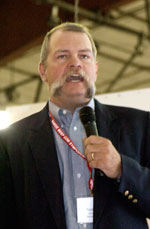Precondition Calves Prior to Sale
Todd Thrift shares ways to increase the likelihood of getting a return on the investment in preconditioning calves.
by Troy Smith for Angus Productions Inc.
MITCHELL, Neb. (Nov. 30, 2011) — Todd Thrift can’t promise that preconditioning calves prior to sale will make a rancher rich, but it could be profitable. Addressing cow-calf producers attending Range Beef Cow Symposium XXII in Mitchell, Neb., the University of Florida animal scientist said a preconditioning program, including vaccinations and weaning calves for 45 days, does add value and potential for premiums.

Todd ThriftThrift said the objective is to take calves through the weaning process and “get them eating and gaining weight.” It should better establish their health status and reduce the incidence of subsequent sickness and loss.
“We want to avoid the wrecks, but also make calves more predictable for feedlot performance and carcass merit,” said Thrift, adding that research data shows it works.
Thrift said the downside is the cost. He called feed the biggest expense, accounting for 70%, 80% and sometimes 90% of the total cost. But there is potential for recovering all of it and more. Heavier payweights should result from calves putting on additional weight during the preconditioning period, but Thrift also cited data showing how preconditioning can reduce shrink at sale time. Additionally, the preconditioning period offers a glimpse of how calves are likely to perform in the feedyard.
Thrift admitted that preconditioning is not always profitable. It depends on cattle kind and quality, and the cost of feed, labor and management. Calves can be preconditioned in a drylot setting, utilizing mostly harvested feedstuffs, or on grazed forage with supplementation.
“The most successful programs I’ve seen involve pasture, because of the lower feed costs,” stated Thrift.
Success may also hinge on how calves are marketed, with “special” preconditioned sales often offering the best potential. Third-party verification of the preconditioning process can lend credibility, but Thrift believes most buyers take producers at their word. He cited potential for garnering premiums of $1.50 to $6 per hundredweight, noting that premiums typically decline during periods of high calf prices.
According to Thrift, preconditioning might be most profitable for calves that are thin or nutritionally challenged calves, such as calves coming out of a drought situation. One thing preconditioning cannot do, he warned, is turn a genetically inferior calf into a superior one.
To view the PowerPoint that accompanied Thrift's presentation, click here.
The biennial Range Beef Cow Symposium was hosted Nov. 29-Dec. 1 at the Mitchell Events Center, Mitchell, Neb., by the cooperative extension and animal science departments of the University of Nebraska-Lincoln, South Dakota State University, Colorado State University and the University of Wyoming. Comprehensive coverage of the event is provided online at www.rangebeefcow.com, an event coverage site provided by Angus Productions Inc. (API), publisher of the Angus Journal and the Angus Beef Bulletin.
Editor’s Note: API's coverage of the event is made available for distribution to all media via an agreement with the Range Beef Cow Symposium Committee and API. Headquartered in Saint Joseph, Mo., API publishes the Angus Journal, the Angus Beef Bulletin, the Angus Beef Bulletin EXTRA, and the Angus e-List, as well as providing online coverage of events and topics pertinent to cattlemen through the API Virtual Library. For questions about this site, or to notifiy us of broken links, click here.

